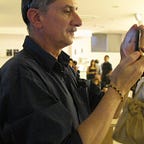Art in the age of its ubiquitous availability
Reflexions on new millennium’s museum
It has now been almost seventy years since Walter Benjamin wrote his famous “The Work of Art in the Age of Mechanical Reproduction”, and in recent decades this reproducible technique has reached very different levels, thanks to the spread of mass of digital technologies. A transformation, this latter, which is about to reach another level, expanding the range of its capabilities in ways not yet fully explored. Suffice to say that, for example, the raid on almost-mass market (but it is a matter of time before it becomes full) of 3D printers, opens multiple perspectives for artists working with sculpture and/or installation, where the impact of this technology will allow — on one side — the manufacturability at very low cost of works previously at high cost, and — on the other — the serial reproducibility of works.
The transition from foundry to 3D printing, could then mark another passing the buoy in the artistic field.
But the real question, already present, it is quite another, and covers all of the visual arts, not only those of new production.
There is an acceleration of techne, which has already changed the scenarios, but which is hard to be achieved by the society, at least in its institutional forms, and more generally in their own self-awareness.
The development of digital communication technologies, especially in recent years, has surged considerably, which has produced in a relatively short time a remarkable increase in transmission capability. This was reflected not only on speed but also on the amount of data transmitted, and then — due it is indeed digital — it has resulted in raising the level of quality.
More information (bit-data), of higher quality, with higher speed.
This jump determined by technological innovation, it should have an impact on a whole host of issues (social, cultural, but economic too) related — also — to the art world. In particular, with regard to that which is the institution symbol, the museum.
By some time, especially in those countries where the cultural debate is more central, there are questions about how this institution is affected by the changes imposed by the modern world — and also, of course, how it can not simply suffer them, but anticipate them, or at least accompany, deeply transforming.
As was rightly noted critic Philippe Daverio *, about the recent exhibition in Bologna (Italy) of Vermeer’s ‘Girl with a pearl earring’, today is possible to see that masterpiece much more comfortably, and much better, from Google Images, rather than live, where you can only “observe behind glass, among the jostling.” And it is no coincidence that some museums have started digitization programs of their most important artworks, making them available online in high definition.
Therefore, we are, in fact, already entered the era of ubiquitous availability of the artwork.
So this is the new paradigm that changes at root not only the idea of the museum, but more generally that of the relationship between man and art. But if this process is not governed in some way , the risk is that it produces a further cultural impoverishment, as paradoxical outcome of the extension and simplification of the access to artwork.
In contrast, a conscious use of the opportunities offered by technology can open up new ways for cultural growth — necessarily passing, therefore, also through an adequate renewal of the cultural institutions.
The museum institution, in particular, in addition to overcoming the role of mere preservation of works of art, must (re)invent an educational role, developing an intelligent and fruitful dialogue with the digital tools, and above all putting in value (in an intelligent and creative manner) that remains the incomparable atout of its cultural offerings: the possibility of empathy with the artwork .
* Huffingtonpost (italian)
